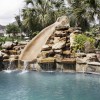According to the U.S. Department of Energy, Swimming pools lose energy in a variety of ways, but evaporation is by far the largest source of energy loss. Evaporating water requires tremendous amounts of energy. It only takes 1 BTU (British thermal unit) to raise 1 pound of water 1 degree, but each pound of 80ºF water that evaporates takes a whopping 1,048 BTU of heat out of the pool.
Outdoor Pool Energy Loss
- Losses to Ground and other 10%
- Radiation to Sky 30%
- Evaporation 70%
The evaporation rate from an outdoor pool varies depending on the pool’s temperature, air temperature and humidity, and the wind speed at the pool surface. The higher the pool temperature and wind speed and the lower the humidity, the greater the evaporation rate. In windy areas, you can add a windbreak-trees, shrubs, or a fence-to reduce evaporation. The windbreak needs to be high enough and close enough to the pool that it doesn’t create turbulence over the pool, which will increase evaporation. You also don’t want the windbreak to shade the pool from the sun, which helps heat it.
Here are some suggestions to follow allowing for a more environmentally friendly swimming pool:
First of all, use Solar Covers also called a solar blanket. Solar Pool Covers or Blankets resemble giant sheets of bubble wrap. The bubbles trap heat from the sun and transmit the heat to the pool, keeping the water temperature warm and inviting. The solar cover also helps to trap the heat of the water and prevents its escape into the cool night time air. Solar covers float freely on top of a pool without tie-downs or anchors to hold them in place. Solar covers are usually folded and stored or rolled-up on a large reel and wheeled out of the way. Solar Blankets are ideal for use in sunny climates because the more heat they can gather, the longer they can extend the swim season. Solar pool covers can raise water temperature by as much as 10-15 degrees.
Besides offering energy savings, pool covers also do the following:
- Conserve water by reducing the amount of make-up water needed by 30%-50%
- Reduce the pool’s chemical consumption by 35%-60%
- Reduce cleaning time by keeping dirt and other debris out of the pool.
Using a Solar Pool Heater is another way that you can take advantage of the sun’s free energy. Solar Heaters are extremely efficient, inexpensive to operate, and are the ultimate in environmental friendliness. When combined with a solar pool cover, Your Solar Pool Heater will maintain a comfortable water temperature well into the cooler months.
Most solar pool heating systems include the following:
- A solar collector – the device through which pool water is circulated to be heated by the sun
- A filter – removes debris before water is pumped through the collector
- A pump – circulates water through the filter and collector and back to the pool
- A flow control valve – automatic or manual device that diverts pool water through the solar collector.
An Example of a solar pool heating system: Pool water is pumped through the filter and then through the solar collector(s), where it is heated before it is returned to the pool. In hot climates, the collector(s) can also be used to cool the pool during peak summer months by circulating the water through the collector(s) at night. Another way to save energy is by using a Pool Filter Timer. Automating a pool’s filter operation pays for itself in energy savings within the first month or two. Except for during times of heavy use, most pools only need to filter 12 hours per day. Pool Filter Timers save money on electricity and chemicals. Most Pool Filter Timers are rugged, weather proof and have up to 50 settings to allow you to make your pool turn on and off whenever you want. Most Pool Timers are easy to program.
Installing and Operating a Swimming Pool Pump for Energy Efficiency
You can save energy and maintain a comfortable swimming pool temperature by using a smaller, higher efficiency pump and by operating it less. In a study of 120 pools by the Center for Energy Conservation at Florida Atlantic University, some pool owners saved as much as 75% of their original pumping bill when they used these energy conservation measures. These savings represent a typical pool in Florida. The average pool pump energy bill is probably higher in Florida than in many other areas of the country because of the long swimming season. While the absolute savings here will be greater there than elsewhere, the percentage savings should apply nationwide. Note that the savings for the combination of measures are not simply the sum of savings for the individual measures. When both are implemented, the energy use is 60% of 40% of the original use-percent savings.The Florida study shows that a 0.75 horsepower or smaller pump is generally sufficient for residential pools. Smaller pumps, which cost less, can be used if you decrease the pool circulation system’s hydraulic resistance by doing the following:
- Substituting a large filter (rated to at least 50% higher than the pool’s design flow rate)
- Increasing the diameter or decreasing the length of the pipes, or replacing abrupt 90-degree elbow pipes with 45-degree ones or flexible pipes.
- By decreasing the pool circulation system’s hydraulic resistance, you can reduce the pump’s electricity use by up to 40%.
References from the US Department of Energy
About the Author: Trey Collier is owner of BackyardCityPools.com – North America’s finest resource for quality pool supplies, including a wide selection of solar pool covers, solar heaters, and pool pumps.







